While mail order companies like Sears-Roebuck & Company catered to household and farm needs about the time Hollywood Cemetery was established, other companies offered funerary art through mail-order catalogs. “White bronze” markers were marketed directly to consumers by catalog and also by the rising cadre of sales agents. Each marker was individually designed, and the material was an industrial age “advanced” alternative to stone grave marker material.
Hollywood has at least one “white bronze” marker, a seven-foot-tall obelisk, for Louisa Exum (died 1908) [Section F, Lot 48]. Anchors protruding from within the recessed areas on the base typically symbolize Christian hope, steadfastness, and eternal life, typifies the understated religious symbolism at Hollywood. Popular circa 1880-1910, the zinc markers were hollow casts, most manufactured by foundries in Connecticut, Michigan, Illinois, Pennsylvania, and Iowa. Although the name of Exum’s manufacturer was not detected, it may be from Monumental Bronze Company in Bridgeport, Connecticut as similar markers in nearby Riverside Cemetery came from that firm.

Photo by Cristie Wright
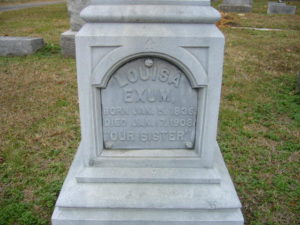
Photo by Cristie Wright
A grave marker style frequently occurring in Hollywood, rusticated stone with partially carved portions in deep relief, may have been mass produced and also available by catalog. The striking similarity among stones of this genre, precise, intricate carving, and more artistic than symbolic motifs hint at a central design and sales source. It combines elements of Classical Revival and traditional symbolism with ideas from more modern building styles, such as Richardsonian. Most in this style category have flowers carved in deep relief, usually on the left side or lower left corner, often on the edge of a scroll text plate, carved into a massive upright rectangular stone approximately four feet tall, three feet wide, and one foot deep. The area surrounding some stones’ text plates is rough (or ashlar cut) while others are polished. Only one similar, and not nearly as elaborately carved, stone was noted in the nearby Riverside Cemetery and none of this style in Old Salem or Mt. Olivet Cemeteries elsewhere in the county. The ashlar stone appearance was popular in Richardsonian architecture from circa 1880 to 1920 and these markers may represent the funerary art translation of the architectural style. Examples include tombstones for the McKinnie family, H. W. White, Mary Emma Birmingham, the Moore-Yates family, S. D. and Annie Waddill, the Swink-House family, and P. B. and Annie Wilkinson.
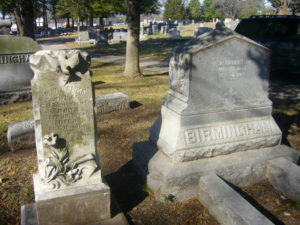
Photo by Cristie Wright
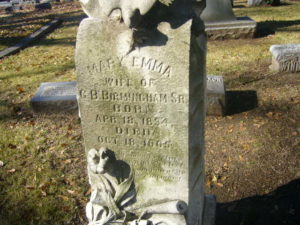
Photo by Cristie Wright
The Moore-Yates marker in Section J, Lot 2, where at least nine members of those families were buried from 1928 to 1971, has rusticated edges, top, and base with a smooth, unpolished face. Three open lilies in deep relief with foliage rest on the upper roll of the text plate scroll, the latter carved in three-quarters relief. The surname Moore is in relief within a rectangular recess and angled slightly across the middle of the facade, while the Yates surname is incised below “Moore.” A dressed stone bench with “Yates” incised across the edge sits beside the tombstone. In front of the bench, a concrete planter adorned with a Greek key motif band around the top and a few clusters of grapes, often symbolizing Christ’s sacrifice or peace or abundance, below rests on a square base ornamented with a center daisy.

Photo by Cristie Wright
D. and Annie Pearcy Waddill (died 1920 and 1935, respectively) [Section E, Lot 5] rest beneath one of the more unusual markers of this style. A scroll text plate unrolls behind a single fern frond in deep relief horizontally across its base. A lotus stem and leaves rise vertically along the left edge of the scroll, and two closed lotus buds, symbolizing resurrection, purity, evolution, or potential, extend upright against the top left rolled edge of the scroll. The front left corner of the marker contains a stylized Corinthian column, with its standard acanthus leafed capital, carved in deep relief extending most of the length of the marker. Above the capital as though on the edge of an entablature appear letters, all but an “S” and two “M’s” undecipherable. The stone’s sides and top and most of the base are rusticated.

Photo by Cristie Wright

Photo by Cristie Wright
A similar rusticated, massive rectangular block grave marker for P. B. and Annie W. Wilkinson (died 1914 and 1919, respectively) [Section B, Lot 65] contains only a large, fluted Grecian urn. The urn, carved in deep relief within the center of the block, extends nearly the full length of the stone. The lip of the urn is fully carved completely across the top of the block, rather than being only in relief. This marker’s design appears artistic rather than symbolic.
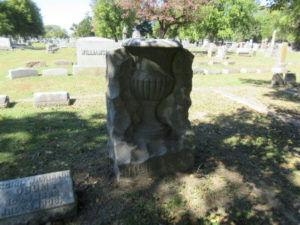
Photo by Cristie Wright
Although smaller and of marble rather than granite, the Mary Emma Birmingham (died 1905) [Section A, Lot 10] white marble stone appears to be in the same style as its flowers exhibit similar deep relief and the carving similar preciseness. It has two lilies, indicating purity, perfection, or light. On top of the marker is a life-sized dove, the traditional symbol of peace. In this case, the dove seems to signify the Holy Spirit plucking a pure, lovely soul from earth to carry as a messenger to heaven.
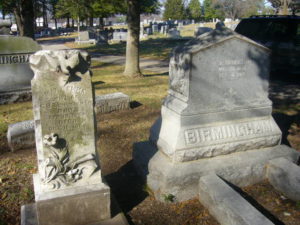
Photo by Cristie Wright


